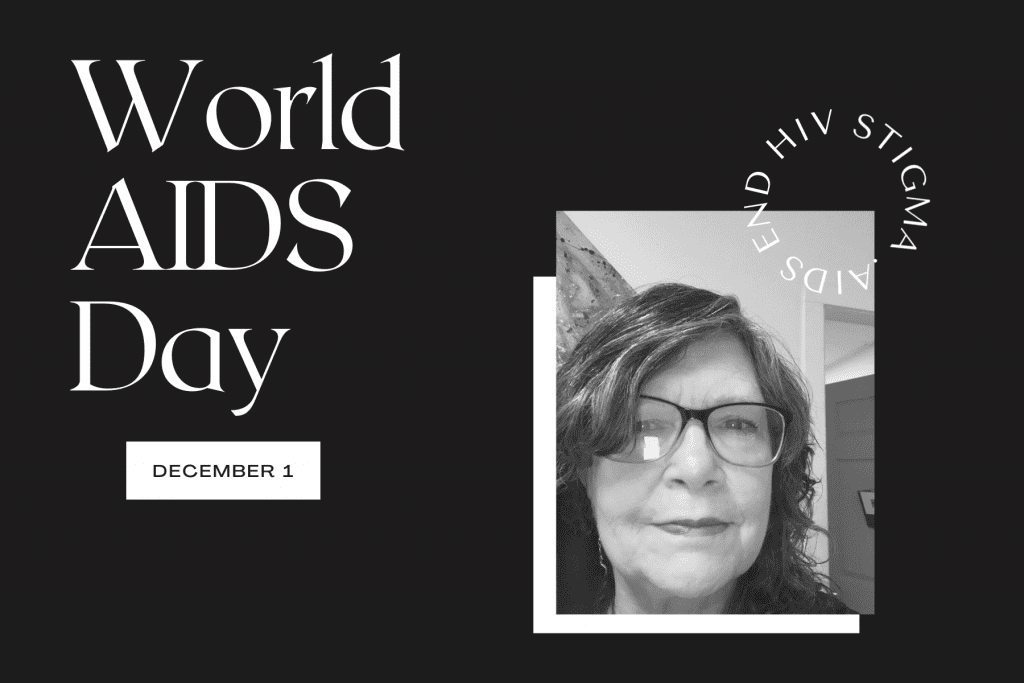While today the news is understandably dominated by COVID-19 pandemic and the drug poisoning crisis, it’s important to continue to raise awareness to the lasting impacts of the AIDS pandemic of decades past.
Annually, on Dec. 1, we commemorate World AIDS Day and the start of Aboriginal AIDS Awareness Week. Support at both a community and a global level are needed more than ever. Despite the many public health challenges we face, we have an opportunity to join our voices to raise awareness about HIV and challenge HIV-stigma.
“HIV transmission is still happening across Canada. There is no cure, and people are still being affected every day. There may be good treatments now, and it is manageable to a degree, but it’s important we don’t lose sight of the fact that this is still impacting so many,” says Kari Hackett, Phoenix’s Director of Programs Fraser East, who oversees “Positive Living” programming that serves more than 90 HIV clients and 155 individuals diagnosed with Hepatitis C.
Every quarter, the Phoenix Society’s drop-in Centre in Abbotsford sees roughly 9,000 visits.
“HIV was a worldwide pandemic and 40 years later, we are still dealing with it. In our Positive Living programs in Abbotsford, our youngest client is five years old,” Hackett noted. “We can all do better to help stop the spread of HIV.”
Janet Wilson, who has been living with HIV for 28 years, has been supported in her journey by the Positive Living programs. She is pictured in the image above.
“It’s odd but when I was diagnosed, I didn’t get upset, the only time I did was when I told other people because they were upset,” says Wilson. “My first thought was ‘So that’s what I’m here for.’ I got involved with an ASO (AIDS-serving organization) and began speaking about HIV to various organizations because in 1997 many women didn’t think they needed to worry about it and straight men didn’t think it applied to them.”
Wilson said having HIV made her a better person, as it has resulted in her becoming more socially conscious, and she still does educational talks.
“I’m very open about my status because I feel that if people are going to shun me because of my status I’d rather know now and not sometime in the future,” she said. “I actually find that people are more receptive to me for being upfront about it.”
It’s Wilson’s belief that she wouldn’t be here without support from AIDS-serving organizations, including the Phoenix Society.
“They helped me physically, mentally and spiritually, I thank God that they were here for me.”
It’s estimated that 65,000 people were living with HIV in Canada at the end of 2014, according to the Canadian government’s latest statistics. Of those, approximately 80% knew their status, 76% of those diagnosed were on treatment, and 89% of people on treatment had achieved viral suppression, which means that the amount of the virus in their blood has been reduced to very low, often undetectable, levels.
Canada signed on to support targets established by the Joint United Nations Programme on HIV/AIDS and the World Health Organization, including the “90-90-90 targets” that by 2020, 90% of all people living with HIV know their status, 90% of those diagnosed receive antiretroviral treatment, and 90% of those on treatment achieve viral suppression.
But those targets have not been realized.
“It’s 2020 and Canada has not met that goal. That’s something that’s at the top of my list in advocacy work with government,” says Hackett.
We know early diagnosis and treatment lead to better health outcomes. People living with HIV, who take HIV medication as prescribed and maintain an undetectable viral load have effectively no risk of passing HIV to their sexual partners.
This has led to the promotion of the U=U campaign, Undetectable=Untransmittable.
—-
In April 2020, Phoenix Society merged with the Positive Living Fraser Valley Society (PLFV), based out of Abbotsford. The decision to bring our organizations together was a simple one; our respective boards saw that with this collaboration our clients would have the opportunity to enter one of the service locations in Abbotsford or Surrey, and be connected to an extensive continuum of services that would start them on their journey to recovery and wellness and help lessen the harms caused by substance use or their HIV/Hepatitis C diagnosis.
The Positive Living programs includes a five-day-a-week mobile van providing Harm Reduction services in Abbotsford and Mission; a Prevention Assessment Referral Clinic (PARC) Drop-in Centre providing services 7 days a week; that sees roughly 9,000 visits per quarter that offers access to shower and laundry services as well as overdose prevention (supervised consumption) peer counselling, naloxone training and access to nurse practitioners; a Food Bank; all in addition to a medical outreach navigator.
Programming also includes two HIV support outreach workers who provide patient transport, counselling and support. There is a high-protein food bank available to those with HIV, support workers will deliver your hampers. A transgender support group also meets onsite (currently online due to COVID).
Programs operate out of the Abbotsford Community Hub Centre which is a 7,000 square-foot space providing a wrap-around model of care for those experiencing health and social challenges, due primarily to poverty, homelessness, drug misuse, mental health and addiction.
Anyone wishing to access services in Abbotsford can contact Carlee ([email protected], 604-854-7701).
For media inquiries, please contact Amy Reid ([email protected])

